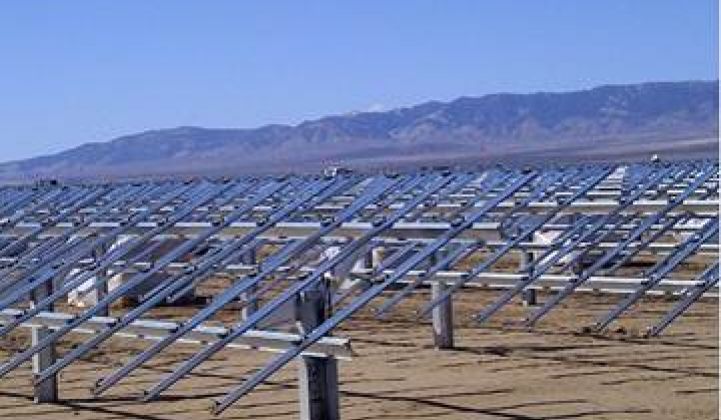Those who live near the 230-megawatt Antelope Valley Solar Ranch One want to know whether the 3.7-million cadmium telluride (CdTe) thin film solar panels First Solar will install in their desert terrain are a threat to them.
“I feel somehow that we’re the experimental rat,” one resident said in an email to GTM. “Cadmium? Hmmmmmmm.”
First Solar Director of Environmental and Sustainable Development Dr. Parikhit Sinha explained to a gathering of local leaders that cadmium telluride, “one of the best known semiconductors,” is not the same thing as cadmium.
A very thin layer of CdTe “allows you to absorb all the light needed to create electricity,” he explained. “This is the key to First Solar’s cost-effective and efficient manufacturing.”
A byproduct of mining, Sinha explained, cadmium is highly toxic and carcinogenic. Exposure can cause lung, kidney or liver pathology or failure. In the presence of tellurium, however, cadmium forms a crystalline lattice that is highly stable (high boiling point, low vapor pressure, low solubility). “It likes to be a solid,” Dr. Sinha said. “It is several orders of magnitude -- a factor of 100 -- less toxic than cadmium.”
CdTe is still a potentially toxic material. But the way it is encapsulated in glass in First Solar panels, Sinha said, sharply limits the possibility of inhalation or ingestion exposure.
“The semiconductor material is bonded to a sheet of glass under very high temperature,” Sinha explained. "An industrial laminate material, ethyl vinyl acetate, a type of plastic, encapsulates the semiconductor and seals it between a second piece of glass.”
Freeing the CdTe from the laminate is the biggest challenge of recycling, Sinha said. It would take a very rare and daunting set of circumstances to both free the CdTe and release cadmium.
But Antelope Valley residents, who know their desert to be a rare and daunting place, were not convinced even when Sinha talked about the accelerated life cycle testing the panels are subjected to and the international certifications they have earned.
Speaking for those who will have to live with the panels, a local noted that First Solar has been in business less than half the 25-year term of the panels’ warranty. The accelerated life cycle testing, another pointed out, covered only ten years. And First Solar’s real-world experience with the panels, he added, is even less than that.
Silicon Valley Toxics Coalition (SVTC) representative Dustin Mulvaney, an Assistant Professor at San Jose State University, works with SVTC to see that materials in computers and solar panels are safely handled and recycled. Mulvaney said First Solar is required to handle PV modules in a way that minimizes any accidental cadmium leakage at other sites. Most likely, he added, the biggest occupational hazard First Solar has encountered on the AVSR1 site is “workers being cut by broken glass.”
Regular plant inspections and power monitoring would be required of First Solar’s on-the-ground maintenance people, Mulvaney explained, which would immediately make them aware of panel damage. Having well-sealed, leak-proof storage bins for broken panels, he said, “is not overly costly or burdensome to a developer.”
Breakage at First Solar power plants, Sinha said, is expected to be one percent over 25 years. In keeping with SVTC-set aims, First Solar has, Sinha indicated, a pre-funded end-of-life take-back and recycling program.

Residents raised questions about the panels’ vulnerability to a desert wildfire. “The amount of fuel that’s available,” Sinha said of the 2,000-acre site that will be replanted with native grasses when construction of the ground-mounted arrays is complete, “is pretty minimal,” so “the maximum temperature would be 800 to 1,000 degrees Celsius for ten to twenty seconds.”
At those temperatures, Sinha said, the CdTe would remain stable. In tests at up to 1,100 degrees Celsius, he added, the CdTe migrated into the heat-softened glass and was encapsulated. Only 0.4 percent of it would be released.
“But 0.4 percent times 3.7 million could be a lot,” a local councilman pointed out, suggesting such a volume of cadmium fumes could make the air toxic or leach into the ground water.
“Like the MBTE problem,” another councilman added.
“But the likelihood of the entire site, or even a significantly large portion of it, being burned without response is low,” Sinha pointed out. For firefighters answering such a call, the biggest danger is the electricity, he said, which they are trained to deal with.
AVSR1’s neighbors next raised questions about unexpected events, like a lightning strike or the crash of a flight from nearby Edwards Air Force Base. Such extreme, highly unlikely occurrences, Dr. Sinha said, are “highly visible” and would, therefore, get an immediate response.
This was little comfort to those who remained dubious. “I majored in common sense,” one email correspondent noted, admitting to no scientific education. “Well, we’re going to learn,” one of the most skeptical concluded.
Others seemed convinced. “Dr. Sinha went a long way toward allaying my fears,” a councilman said. He added that he now feels “much more confident” that the community “can live with this technology.”
First Solar’s efforts to demonstrate the safety of its technology followed ongoing efforts to demonstrate the opportunity in solar power plant development. The company has gifted $350,000 in community benefits and, with the project still less than half complete, has spent over a quarter of a million dollars with local vendors. In addition, AVSR1 is already providing 200 full-time construction jobs, a number that will soon go to 350, in a region where unemployment has been 15 percent.



